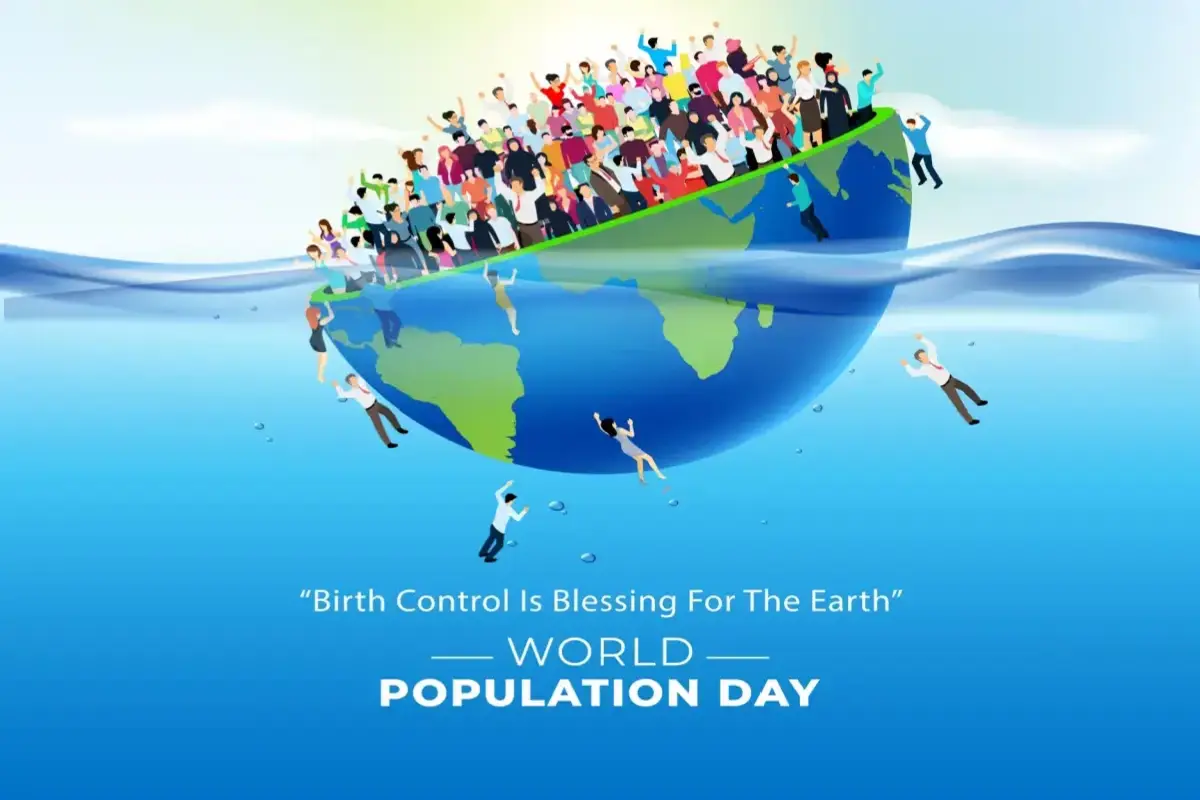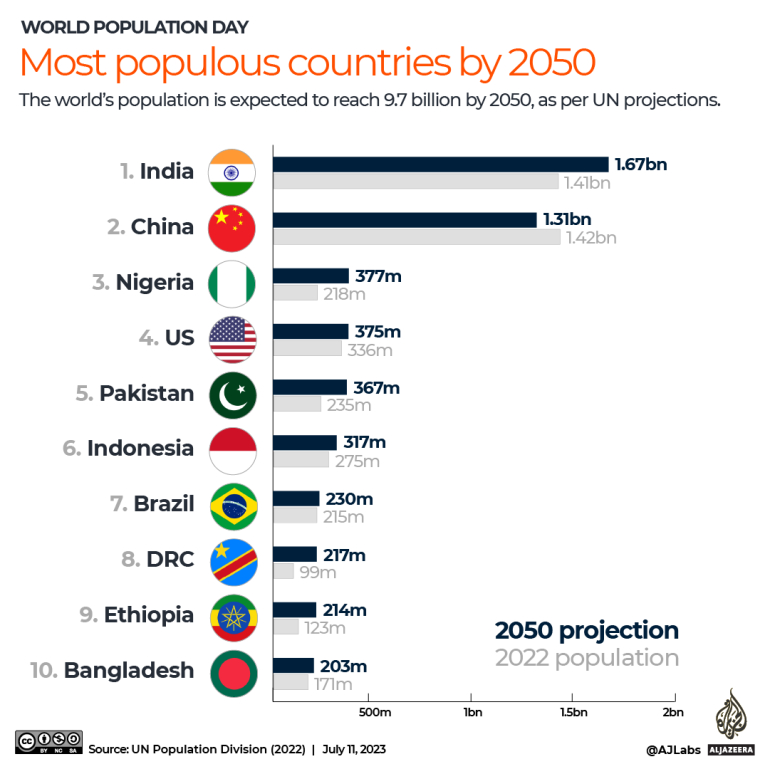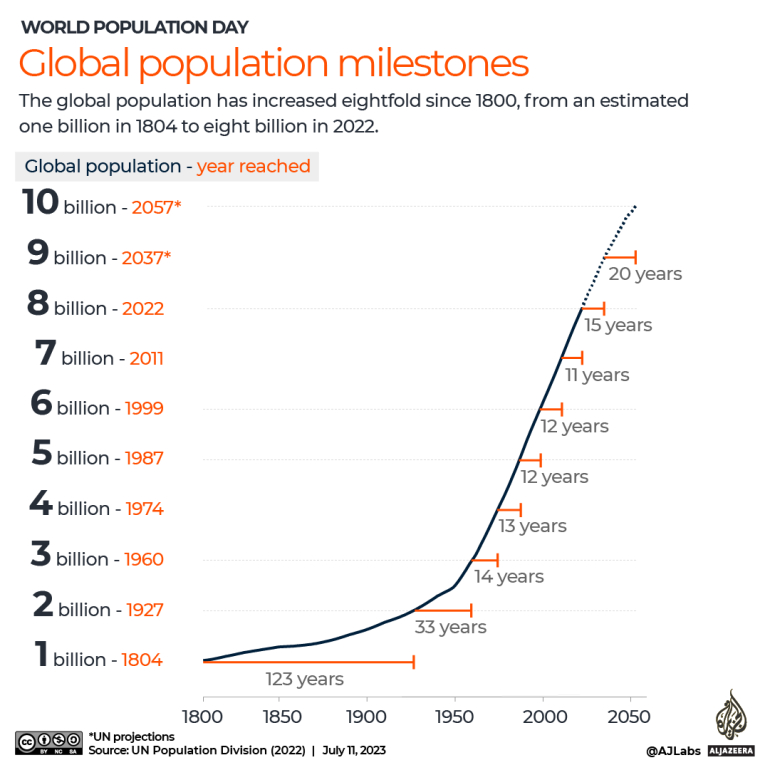News
World Population Day: Global Milestones, Declining Growth, And Implications For The Future

(CTN NEWS) – World Population Day, recognized worldwide on July 11, is a designated occasion by the United Nations to highlight the pressing significance of population matters and their interconnections with the environment and human development.
In the preceding year, two notable population milestones were witnessed across the globe. Firstly, in November 2022, the global population reached a significant milestone of eight billion individuals.
Secondly, in April of this year, as per estimates from the United Nations, India surpassed China and became the most populous country in the world.
While global population growth continues, the pace of this growth is actually decelerating.
Earlier this year, South Korea once again set a new record for having the world’s lowest fertility rate, joining other Asian countries such as Japan and China in experiencing their lowest birth rates.
In a series of informative infographics, Al Jazeera provides a breakdown of global population figures and explores the implications of declining populations for the rest of the world.
The Remarkable Tripling of the World’s Population in 70 Years
Back in 1955, the Earth was home to 2.8 billion people. Today, that number is equivalent to the combined population of India and China alone.
The animation presented below illustrates how the world’s population grew threefold, from 2.5 billion individuals in 1950 to 8 billion in 2022.
According to estimates from the United Nations Population Division, the global population is projected to reach approximately 9.7 billion people by 2050.
By the year 2050, Nigeria is projected to become the world’s third most populous country, following India and China. It will be followed by the United States, Pakistan, Indonesia, Brazil, the Democratic Republic of the Congo, Ethiopia, and Bangladesh, in that specific sequence.
Is the population of your country growing or shrinking?
To determine whether a country’s population is growing or shrinking, we consider four key factors: births, deaths, immigration (people entering the country), and emigration (people leaving the country).
If the number of births and immigration exceeds the number of deaths and emigration, the population of the country will grow. Conversely, if the opposite occurs, the population will decline.
In 2022, approximately 134 million babies were born worldwide, which averages to around 367,000 newborns per day. While this might seem like a substantial figure, it is actually the lowest number of newborns since 2001.
The global number of deaths has been gradually increasing, rising from less than 50 million prior to the 1990s to 58 million in 2019. However, the COVID-19 pandemic significantly impacted this figure, resulting in a sharp increase in deaths.
In 2020, there were 63 million recorded deaths, followed by a record-breaking 69 million in 2021. Estimates indicate that around 67 million deaths occurred in 2022.
The net outcome of these factors is a global population growth rate of 0.8 percent.
Africa, known as the fastest-growing continent worldwide, boasts several countries such as Niger, Uganda, DRC, Angola, Chad, Mali, and Somalia, each experiencing an annual growth rate exceeding 3 percent.
Conversely, the majority of the world’s fastest-shrinking populations are found in Europe and East Asia. In response to declining birth rates, governments have implemented a wide array of financial incentives and support programs targeting new mothers.
To avert an impending demographic and economic crisis, South Korea, for instance, offers cash payments of $10,500 to new parents.
Diminishing and aging populations present significant challenges to labor markets and the overall economy.
In addition to a decline in the working-age population, substantial reforms will be necessary to adapt social services and healthcare systems to accommodate the increasingly elderly populations.
What is the typical age in your country?
A valuable measure to comprehend a country’s population is to examine its median age, which indicates the age at which half of the population is older and half is younger.
Remarkably, the global median age has surpassed 30 years for the first time in recorded history.
The following table provides a ranking of the world’s median age, arranged from the oldest to the youngest.
| 1 | Niger | 14.5 | 25.3M | 6.82% | 3.7% |
|---|---|---|---|---|---|
| 2 | CAR | 14.7 | 5.5M | 5.98% | 1.58% |
| 3 | Chad | 15.0 | 17.2M | 6.26% | 3.14% |
| 4 | Mali | 15.1 | 21.9M | 5.96% | 3.14% |
| 5 | Somalia | 15.2 | 17.1M | 6.31% | 3.1% |
| 6 | Burundi | 15.6 | 12.6M | 5.08% | 2.62% |
| 7 | DRC | 15.6 | 95.9M | 6.16% | 3.17% |
| 8 | Uganda | 15.9 | 45.9M | 4.59% | 3.19% |
| 9 | South Sudan | 16.1 | 10.7M | 4.47% | 1.51% |
| 10 | Angola | 16.2 | 34.5M | 5.3% | 3.16% |
| 11 | Burkina Faso | 16.6 | 22.1M | 4.77% | 2.6% |
| 12 | Afghanistan | 16.7 | 40.1M | 4.64% | 2.4% |
| 13 | Gambia | 16.8 | 2.6M | 4.68% | 2.5% |
| 14 | Malawi | 16.8 | 19.9M | 3.92% | 2.58% |
| 15 | Mozambique | 16.8 | 32.1M | 4.64% | 2.75% |
World Population Day: World Population’s Billion Milestones
World population’s billion milestones have been remarkable. Since 1800, the global population has multiplied eightfold, soaring from an approximate one billion in 1804 to reach eight billion in 2022.
This remarkable growth can largely be attributed to the advancements in modern medicine and the industrialization of agriculture, which greatly increased global food production and supplies.
- One billion – 1804
- Two billion – 1927 (took 123 years)
- Three billion – 1960 (took 33 years)
- Four billion – 1974 (took 14 years)
- Five billion – 1987 (took 13 years)
- Six billion – 1999 (took 12 years)
- Seven billion – 2011 (took 12 years)
- Eight billion – 2022 (took 11 years)
- Nine billion – 2037* (UN projections)
- Ten billion – 2057* (UN projections)
As the global population continues its ascent, experts in demographics have highlighted that the annual growth rate has steadily declined to less than 1 percent.
Based on these estimations, it is anticipated that the world’s population will reach its peak at approximately 10.4 billion individuals in the 2080s and maintain that level until 2100.
RELATED CTN NEWS:
Saudi Arabia Deposits $2 Billion In State Bank of Pakistan, Boosting Foreign Exchange Reserves
Five Key Takeaways As UPS Strike Looms With Failed Teamsters Contract Talks
US Marine Corps Leadership In Limbo As Senator’s Abortion Protest Blocks Military Appointments































